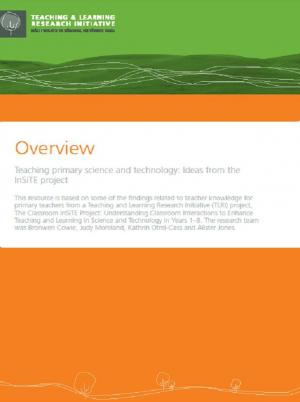You are here
Home › TLRI research › Research completed › School sector › The Classroom InSiTE Project: Understanding classroom interactions to enhance teaching and learning in science and technology in Years 1–8The Classroom InSiTE Project: Understanding classroom interactions to enhance teaching and learning in science and technology in Years 1–8
Project Description
What really counts in education is what happens when teachers and students meet.
The wisdom of any decision about education is best judged on the basis of whether or
not it raises the quality of these interactions. (Atkin and Black, 2003, p. ix)
A significant goal of the Classroom InSiTE (Classroom Interactions in Science and Technology Education) research project was to develop a more robust understanding of, and to enhance, classroom interactions as a key aspect of assessment for learning (AfL) interactions. International research suggests that AfL practices are effective in enhancing student achievement, and may be particularly effective with students who are low achievers (Black and Wiliam, 1998). AfL can be distinguished from other forms of assessment by its purpose, which is to enhance student learning. The contingent and emergent nature of AfL means that it is generally embedded in and accomplished through teacher–student classroom interactions.
For teachers, undertaking AfL is demanding and complex. To assess and respond to student learning, teachers need a detailed understanding of possible student learning pathways, along with the ability to develop and deploy pedagogical strategies to ascertain students’ current understandings and to move their learning forward. The blending of teacher content knowledge and pedagogical knowledge to a form appropriate for their particular students is commonly referred to as pedagogical content knowledge (PCK) (Shulman, 1987). New Zealand primary teachers have indicated that they can lack confidence in their ability to teach science and technology and that they are interested in developing their practice in these areas (McGee et al., 2003). This project built on that interest.
A sociocultural perspective towards learning and pedagogy underpinned the InSiTE study. Sociocultural perspectives are increasingly being used to make sense of classroom teaching and learning because they acknowledge complexity and the impact of interactions between people, ideas, tools, and settings over time (Wertsch, 1998).
Project Outputs
2011
|
The TLRI InSiTE project explored teaching and learning in science and technology in Years 1–8. The co-ordination team at TLRI then commissioned members of that research team to look at how to disseminate the findings, including focus groups with teachers about what works for them. The result is a series of publications contained in a freshly designed TLRI folder.
|
 |
2006
Presentations, conferences and workshops
Cowie, B., & Otrel-Cass, K. (2006). Activity theory in early years' science lessons. Paper presented at the annual conference of the New Zealand Association for Research in Education, Rotorua, 5 to 8 December
Moreland, J., Deeley, C., Cowie, B., Ryan, B., Otrel-Cass, K., & Jones, A. (2006). The role of focal artifacts in the structuring and shaping teaching and learning in whole class settings. Paper presented at the annual conference of the New Zealand Association for Research in Education, Rotorua, 5 to 8 December.
2005
Presentations, conferences and workshops
Outputs
-
 Cowie, B., Moreland, J., Jones, A., & Otrel-Cass, K. (2008). Classroom InSITE project Understanding classroom interactions to enhance teaching and learning in science and technology in Years 1–8:Summary. Wellington: Teaching Learning Research Initiative -
pdf -
69.54 KB
Cowie, B., Moreland, J., Jones, A., & Otrel-Cass, K. (2008). Classroom InSITE project Understanding classroom interactions to enhance teaching and learning in science and technology in Years 1–8:Summary. Wellington: Teaching Learning Research Initiative -
pdf -
69.54 KB -
 Cowie, B., Moreland, J., Jones, A., & Otrel-Cass, K. (2008). Classroom InSITE project Understanding classroom interactions to enhance teaching and learning in science and technology in Years 1–8:Final Report. Wellington: Teaching Learning Research Initiative -
pdf -
1.45 MB
Cowie, B., Moreland, J., Jones, A., & Otrel-Cass, K. (2008). Classroom InSITE project Understanding classroom interactions to enhance teaching and learning in science and technology in Years 1–8:Final Report. Wellington: Teaching Learning Research Initiative -
pdf -
1.45 MB -
 Insite Overview -
pdf -
295.63 KB
Insite Overview -
pdf -
295.63 KB -
 Insite Design Thinking -
pdf -
499.72 KB
Insite Design Thinking -
pdf -
499.72 KB -
 Insite Planning -
pdf -
555.14 KB
Insite Planning -
pdf -
555.14 KB -
 Insite Interaction -
pdf -
433.13 KB
Insite Interaction -
pdf -
433.13 KB -
 Insite Teacher Stories -
pdf -
1001.16 KB
Insite Teacher Stories -
pdf -
1001.16 KB

